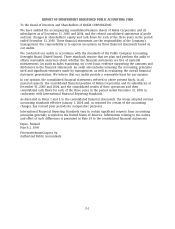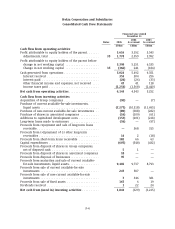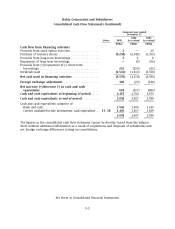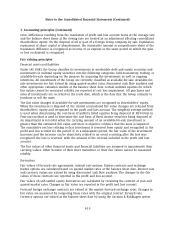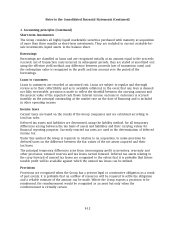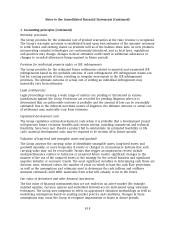Nokia 2005 Annual Report Download - page 148
Download and view the complete annual report
Please find page 148 of the 2005 Nokia annual report below. You can navigate through the pages in the report by either clicking on the pages listed below, or by using the keyword search tool below to find specific information within the annual report.Notes to the Consolidated Financial Statements (Continued)
1. Accounting principles (Continued)
rates. Differences resulting from the translation of profit and loss account items at the average rate
and the balance sheet items at the closing rate are treated as an adjustment affecting consolidated
shareholders’ equity. On the disposal of all or part of a foreign Group company by sale, liquidation,
repayment of share capital or abandonment, the cumulative amount or proportionate share of the
translation difference is recognized as income or as expense in the same period in which the gain
or loss on disposal is recognized.
Fair valuing principles
Financial assets and liabilities
Under IAS 39(R), the Group classifies its investments in marketable debt and equity securities and
investments in unlisted equity securities into the following categories: held-to-maturity, trading, or
available-for-sale depending on the purpose for acquiring the investments as well as ongoing
intentions. All investments of the Group are currently classified as available-for-sale. Available-for-
sale investments are fair valued by using quoted market rates, discounted cash flow analyses and
other appropriate valuation models at the balance sheet date. Certain unlisted equities for which
fair values cannot be measured reliably are reported at cost less impairment. All purchases and
sales of investments are recorded on the trade date, which is the date that the Group commits to
purchase or sell the asset.
The fair value changes of available-for-sale investments are recognized in shareholders’ equity.
When the investment is disposed of, the related accumulated fair value changes are released from
shareholders’ equity and recognized in the profit and loss account. The weighted average method
is used when determining the cost-basis of publicly listed equities being disposed of. FIFO (First-in
First-out) method is used to determine the cost basis of fixed income securities being disposed of.
An impairment is recorded when the carrying amount of an available-for-sale investment is
greater than the estimated fair value and there is objective evidence that the asset is impaired.
The cumulative net loss relating to that investment is removed from equity and recognized in the
profit and loss account for the period. If, in a subsequent period, the fair value of the investment
increases and the increase can be objectively related to an event occurring after the loss was
recognized, the loss is reversed, with the amount of the reversal included in the profit and loss
account.
The fair values of other financial assets and financial liabilities are assumed to approximate their
carrying values, either because of their short maturities, or their fair values cannot be measured
reliably.
Derivatives
Fair values of forward rate agreements, interest rate options, futures contracts and exchange
traded options are calculated based on quoted market rates at the balance sheet date. Interest rate
and currency swaps are valued by using discounted cash flow analyses. The changes in the fair
values of these contracts are reported in the profit and loss account.
Fair values of cash settled equity derivatives are calculated by revaluing the contract at year-end
quoted market rates. Changes in fair value are reported in the profit and loss account.
Forward foreign exchange contracts are valued at the market forward exchange rates. Changes in
fair value are measured by comparing these rates with the original contract forward rate.
Currency options are valued at the balance sheet date by using the Garman & Kohlhagen option
F-10



